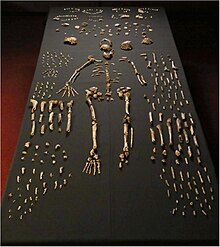ஹோமோநலேடி
ஹோமோ நலேடி (Homo naledi) என்கின்ற மனிதஇனப் படிமங்களை தென் ஆப்பிரிக்காவில் உள்ள கடெங் என்ற மாநிலத்தில் ஜோகானஸ்பேர்க் நகரத்தில் இருந்து வடமேற்கில் 50 கிலோ மீட்டர் தூரத்தில் அமைந்துள்ள ரைசிங் ஸ்டார் (Rising Star) என்ற குகையில் 40 மீட்டர் மேற்பரப்பின் கீழ் உள்ள அறையில் 2013 ஆம் ஆண்டு ரிக் அண்டர் மற்றும் ஸ்டீவன்டக்கர் ஆகியோர் கண்டு பிடித்தனர்.
- 2015 ஆம் ஆண்டில் செப்டம்பரில் ஹோமோ நலேடி படிமங்களைப் பற்றி 47 ஆராய்ச்சியாளர்கள் கொண்ட குழு அதிகாரபூர்வமாக அறிவித்தது.
- இவ்வாராய்ச்சிக் குழுவின் தலைவரான விட்வாட்டர்ஸ்ரேண்ட் பல்கலைக்கழகம் மானிடவியல் துறையைச் சார்ந்த லீ பெர்கர் இந்த புது மனித இன படிமங்களை ஹோமோ நலேடி இனத்தைச் சேர்ந்தவை என்று உறுதிப்படுத்தினார். [2]
| ஹோமோநலேடி புதைப்படிவ காலம்:[1] | |
|---|---|

| |
| 1,550 வன்கூட்டு மாதிரிகள் கண்டெடுக்கப்பட்டுள்ளன | |
| உயிரியல் வகைப்பாடு | |
| திணை: | விலங்கு
|
| தொகுதி: | |
| வகுப்பு: | |
| வரிசை: | |
| குடும்பம்: | |
| இனக்குழு: | |
| பேரினம்: | |
| இனம்: | H. naledi
|
| இருசொற் பெயரீடு | |
| Homo naledi லீ. ஆர். பெர்ஜெர் (Lee R. Berger) et al., 2015 | |

| |
| அமைவிடம், கடெங், தென்னாப்பிரிக்கா | |
மேற்கோள்கள்
தொகு- ↑ Dirks, Paul H.G.M.; Roberts, Eric M. et al. (9 May 2017). "The age of Homo naledi and associated sediments in the Rising Star Cave, South Africa". eLife 6: e24231. doi:10.7554/eLife.24231. https://elifesciences.org/content/6/e24231.Full list of authors
- Paul H.G.M. Dirks
- Eric M. Roberts
- Hannah Hilbert-Wolf
- Jan D. Kramers
- John Hawks
- Anthony Dosseto
- Mathieu Duval
- Marina Elliott
- Mary Evans
- Rainer Grün
- John Hellstrom
- Andy I.R. Herries
- Renaud Joannes-Boyau
- Tebogo V. Makhubela
- Christa J. Placzek
- Jessie Robbins
- Carl Spandler
- Jelle Wiersma
- Jon Woodhead
- Lee R. Berger
- ↑ Lee Rogers Berger (10 September 2015). "Homo naledi, a new species of the genus Homo from the Dinaledi Chamber, South Africa". eLife 4. doi:10.7554/eLife.09560. பப்மெட்:26354291. பப்மெட் சென்ட்ரல்:4559886. http://elifesciences.org/content/4/e09560.full. பார்த்த நாள்: 10 September 2015. Lay summary. "If the fossils prove to be substantially older than 2 million years, H. naledi would be the earliest example of our genus that is more than a single isolated fragment. [...] A date younger than 1 million years ago would demonstrate the coexistence of multiple Homo morphs in Africa, including this small-brained form, into the later periods of human evolution.".
Full list of authors
- Lee R. Berger
- John Hawks
- Darryl J. de Ruiter
- Steven E. Churchill
- Peter Schmid
- Lucas K. Delezene
- Tracy L. Kivell
- Heather M. Garvin
- Scott A. Williams
- Jeremy M. DeSilva
- Matthew M. Skinner
- Charles M. Musiba
- Noel Cameron
- Trenton W. Holliday
- William Harcourt-Smith
- Rebecca R. Ackermann
- Markus Bastir
- Barry Bogin
- Debra Bolter
- Juliet Brophy
- Zachary D. Cofran
- Kimberly A. Congdon
- Andrew S. Deane
- Mana Dembo
- Michelle Drapeau
- Marina C. Elliott
- Elen M. Feuerriegel
- Daniel Garcia-Martinez
- David J. Green
- Alia Gurtov
- Joel D. Irish
- Ashley Kruger
- Myra F. Laird
- Damiano. Marchi
- Marc R. Meyer
- Shahed. Nalla
- Enquye W. Negash
- Caley M. Orr
- Davorka Radovcic
- Lauren Schroeder
- Jill E. Scott
- Zachary Throckmorton
- Matthew W. Tocheri
- Caroline VanSickle
- Christopher S. Walker
- Pianpian Wei
- Bernhard Zipfel
மேலதிக வாசிப்புக்கு
தொகு- Berger, L. R.; Hawks, J. (2017). Almost human: the astonishing tale of Homo naledi and the discovery that changed our human story. Washington, DC: National Geographic Society. பன்னாட்டுத் தரப்புத்தக எண் 978-1-4262-1811-8.